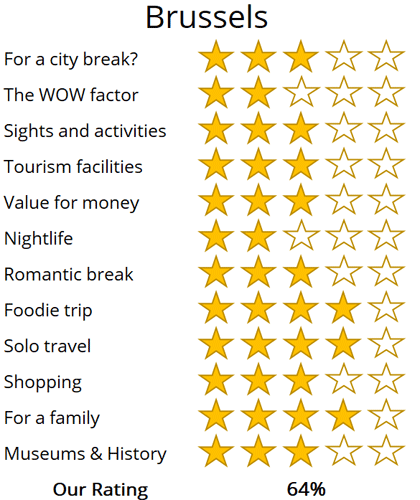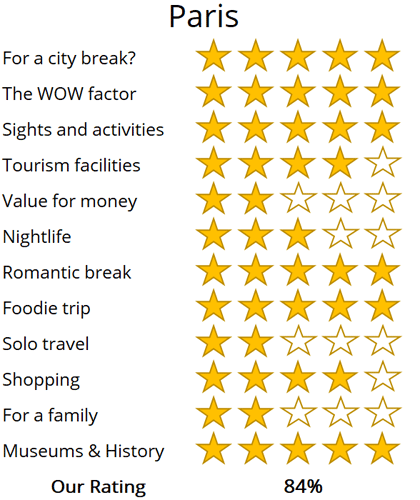WhereToGoForMyHoliday.com
The best destination comparison site!
WhereToGoForMyHoliday.com
The best destination comparison site!
Brussels or Paris a vs city comparison and travel guide
Brussels and Paris both offer unique and enticing experiences, but which one should you choose for your city break or holiday?
We understand your dilemma. There is an abundance of travel guides for both cities, but few actually comparing them, and advising you which is the better for your trip.
This article will provide our unbiased and independent views of Paris and Brussels, hopefully making your choice that little easier.
The article is structured into several sections, each of which can be directly accessed through the following links:
• Introduction to the cities
• Scores and ratings
• Which one should I, friends, or family visit?
• When to visit and weather
• Who is the city suited for?
• The perfect 48hours (with map)
• Tourism details (where to stay? airport details?)
Introduction to Paris and Brussels
It is all too easy to over-look Brussels as a city break destination, especially considering it is the home of modern European politics.
However, there is a surprising amount here to explore and enjoy, and a visit here can end up being one of those unexpected hits that with hindsight, you can’t understand why you hadn’t been before.
Being smaller than many of its European counterparts it is able to offer the perks of a more manageable and friendly atmosphere with fewer crowds, exceptional art galleries, museums and medieval churches abundant around every cobbled street corner.
It is also brimming with quirky café charm and home to the highest standard of food you will find anywhere in the world.
Paris is famed as the capital of Romance, the epicentre of French culture and grand European art, and the home of iconic monuments like the Eiffel Tower. There's no question that it's an amazing city to explore.
Everywhere you go along the Seine River it seems like there's a world-class museum or gallery beckoning. But Paris can also be overwhelming, not to mention downright gritty in some parts.
The history here goes back to the Celtic tribes of the 400s BC. But it was the 7th-century fortifications on the Île de la Cité that went on to form the medieval kernel of the town.
The capital still radiates out from that, with bohemian neighborhoods along the Canal Saint-Martin, stereotypically Parisian cafes and cobbled streets in Montmartre, and enthralling cultural and foodie attractions throughout other arrondissements (areas).

The Mont des Arts gardens in central Brussels
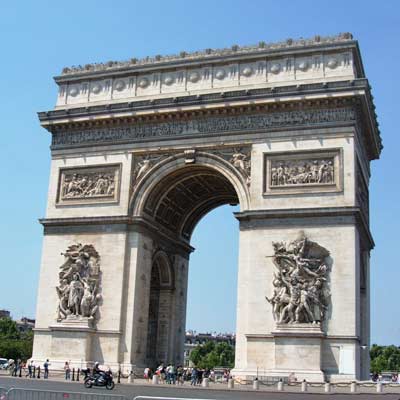
The Arc de Triomphe, constructed as a memorial to the soldiers who perished in the Napoleonic Wars and French Revolution
Brussels vs Paris: City Ratings
Summary
Where would I journey for a personal escape?
Paris
Where would I send my parents for a memorable visit?
Paris
Where's the ideal destination for my adventurous 19-year-old cousin?
Paris
Where should my food-obsessed friend indulge their culinary passions?
Paris
Note: The above comparisons are weather-independent and are based on travel during the most opportune times of the year. Details about the ideal travel seasons are elaborated upon later in this article.
In the sections that follow, you'll find a comprehensive comparison between these two fascinating cities. This includes recommendations on the duration of stay, the best times to visit, and tailored 48-hour itineraries for each city.
The final segment delves into practicalities for your travels, such as the best airport to fly into, the optimal districts for your accommodation, and insider tips, for when you come to explore the city.
We hope that you find all of this information useful, in planning your next exciting trip!
Destination details
How long to spend each city?
Paris could take a lifetime to explore completely. This is a living, breathing, sprawling capital city, which means even the locals can be surprised at the new cafes, bistros, and cultural events that come and go. For travellers, at least three days is a good idea.
That's probably just enough to see the mainstay sights and hop into the Louvre to catch a glimpse of the Mona Lisa. Trips to explore outer arrondissements and sample Paris's pumping nightlife should probably be between four days and a whole week, with more extensions needed if you want to hit the Loire Valley for wine tasting.
Brussels, with its compact layout, allows visitors to explore its main attractions within 1 or 2 days, primarily centered around the historical core.
A leisurely stroll from the Grote Markt (The Grand Place), the heart of the city, to the EU Parliament, passing through the lively Stalingrad District, takes just a couple of hours—though this may vary depending on your penchant for Belgian beer stops along the way!
If time permits, consider day trips to the historic battlefield of Waterloo or the charming medieval city of Bruges, both offering unique insights into Belgium’s rich heritage.
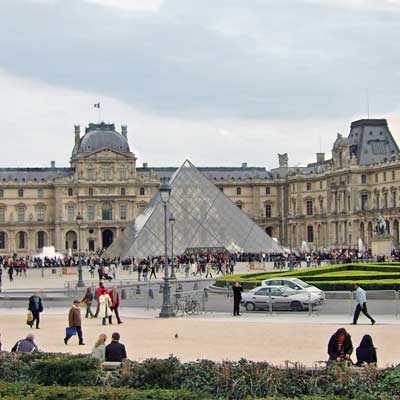
The Louvre with its distractive glass pyramid

The Saint Jacques-sur-Coudenberg church, Brussels
Brussels gets busiest during the warm months of the summer. Everyone from city breakers flying in on short-haul budget links to Interrail backpackers on a cross-continent grand tour pass through during the main holidays from June and August.
There's a real buzz about the bars of the Grand Place then, with people chatting and snapping selfies all around the UNESCO-tagged streets. Some downsides: Brussels can have heatwaves, and the price of hotels at this time is sure to be peaking.
While winter is probably best avoided unless you're on the hunt for cosy Christmas markets, spring and autumn have their pluses. They're both typically cheaper. There's fewer people around, so you're more likely to score tours of the EU Parliament and whatnot. And everything costs a little less, from hotels to flights deals into town.
Paris is known for its café culture, it would be a shame to miss all those al fresco coffees on the canal side. Enjoyments like that are most likely to be had in the warmer months, which – this far north in France – means May to September.
Outside of those, the rainfall picks up and things get chilly. That said, the summer is the most expensive and busy part of the year, so you'll be contending with others for those selfies by the Eiffel Tower.
Visits pre-Christmas tend to be pricier than those after Christmas. If you're eager to cosy up and see Paris in the ice and cold, you might want to push your break to February or March. Those months tend to be nice, quiet and free from the tourist masses.
Paris is a master of art and culture. From the gold-gilded palaces of Versailles to the endless works of the Louvre and the Musée d'Orsay, you'll never be short on paintings or architecture or sculpture.
But the best Paris trips mix all that with a little bit of food, some classic sightseeing, and even a touch of hedonism. That makes this a versatile city-break option, offering wine bars and bucket-list attractions like the Eiffel Tower.
It's probably worth dodging Paris if you're not the sort who deals well with crowds, traffic, and big cities. The nearest place you can go to escape to nature are the forest parks on the outskirts. What's more, it can take a while to get from A to B in the French capital.
One of the great joys of Brussels is just how many facets there is to the city. You're certain to be entertained if you love architecture. The main square alone comes with Gothic, Neo-Gothic, and Renaissance elements.
Then there's all that fabled Belgian food, from the double-cooked chips to the chocolate-topped waffles to the frothy monk-brewed beers you find in the pubs. Add in enthralling tours of important parliament buildings, pretty parks, and some seriously rich galleries, and you've got a destination suited to all sorts.
Of course, some people might not feel right at home, Brussels is urban to the core. Finally, budget seekers could find themselves a little happier elsewhere. Brussels hardly breaks the bank, but it's no penny saver either.

The Arc de Triomphe leads to the Park du Cinquantenaire
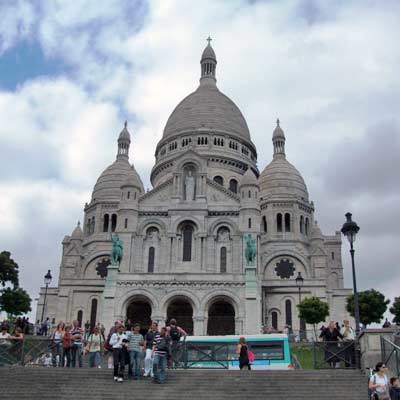
The Sacré-Cœur provides one of the finest view of Paris
Paris in 48 hours is a hard ask, but this itinerary should help distil the city's preeminent culture, art and atmosphere into two short days:
Day 1: Breakfast time in the 19th arrondissement. Local and traveller joints meet there, with some charming cafés and bakeries lining Le Bassin de la Villette, where there are open-air swimming spots in the summer months. Then, move south-west along the picturesque Canal Saint-Martin.
It takes you to the beating heart of the city, just shy of where the Île de la Cité hosts the beautiful Cathedral of Notre Dame. Take your photos and then move across the Seine River to the famous Latin Quarter.
It's the perfect place to explore in the afternoon, with boutique bookshops and atmospheric cafés aplenty. For the afternoon, cross the water again and duck into the Louvre Museum.
The morning rush should have subsided, so you can wander the exhibition rooms in search of the Mona Lisa and the Venus de Milo without having to jostle with too many. In the evening, return westwards to hipster Belleville. This district is one of Paris's Chinatowns, with more noodle shops and dim sum outlets than you can shake your guidebook at.
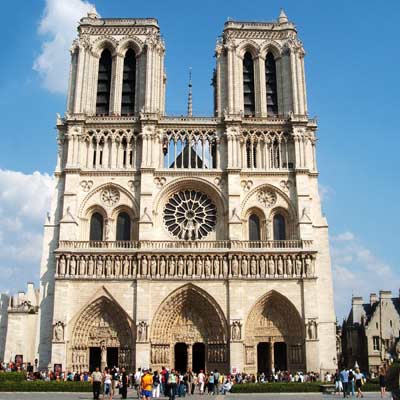
Notre-Dame
Day 2: Seek out the bohemian neighborhood of Montmartre to start your second day in Paris. It's known for its zigzagging cobbled streets and urban staircases, but also comes replete with cosy coffee houses with crispy croissants. At the very top of the hill where the district is draped is the gorgeous Sacré-Cœur. Its great travertine domes gaze over the city, so expect some awesome views.
On the way down, heading west, you might just pass by the infamous Moulin Rouge and its makeshift windmill all lit up in red neon. You can catch a metro from that to go along to Ternes. Emerge and you'll be looking straight down at the Arc de Triomphe, which marks the start of the Champs-Élysées – a place to shop till you drop.
Be sure to pull yourself from that grand boulevard with enough time (and light) left to see the Eiffel Tower in all its glory. The landmark is just over the river to the south, but the best view might be from the Trocadéro Gardens on the northern banks.
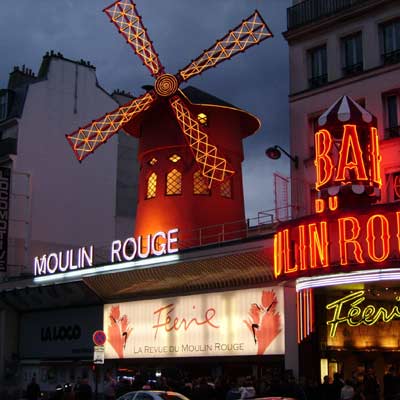
The Moulin Rouge
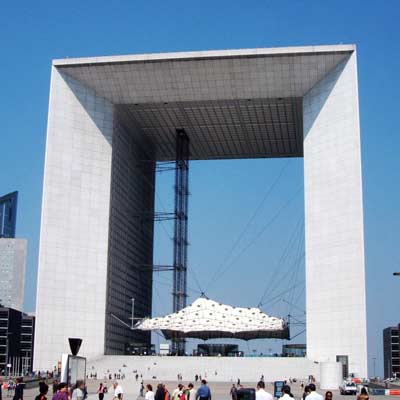
La Défense is the modern side to grand Paris
48hours in Brussels
A whirlwind 48 hours in Brussels can take you from curious statues to modernist structures, regal parklands to beautiful palaces. Of course, there's plenty of time to fit in home-brewed beers and indulgent waffles along the way.
Day 1: The Grand Place is the only real place to begin in Brussels. A UNESCO World Heritage Site, it is the kernel of the city, and has been since time immemorial. Look to the north end and you can see the elegant façade of the Brussels City Museum. It's housed in the Neo-Gothic Maison du Roi, hosting collections that include masterworks by Flemish painters and the original Manneken Pis statue (more on him later).
On the south flank is the indomitable Brussels Town Hall. Gaze up at its gorgeous medievalist spire and wonder at the carvings of dukes on the portals. The rest of the square is a photographer's dream, with guild houses and pubs and more. Next, the area of Stalingrad calls. Curiously named, it's nonetheless one of the liveliest quarters of Brussels.
It's also where you'll find the famously underwhelming Manneken Pis statue – we won't spoil it with a description! After lunching in one of the taverns there, head east to the acclaimed Royal Museum of Fine Arts of Belgium. It's a must for any culture vultures, what with exhibits that contain works by the likes of Anthony van Dyck, Bruegel, and Rubens. It demands a whole afternoon.

The town hall on the Grand Place, the main plaza of Brussels
Day 2: Overdosed on art and ready for something completely different? Good, because day two begins at the Espace Léopold. Welcome to the vast European Parliament; the corridors of power for 27 states that range from Romania to Portugal. Tours of the huge debating chamber and the plenary rooms where the decisions are made run daily from 9am.
After an hour inside, you can head for the grand Parc du Cinquantenaire that sits just behind. It's a prime example of Brussels' flamboyant public garden style, hosting the eye-watering Arc du Cinquantenaire, a national symbol of Belgium.
The afternoon sees you hop on trams (a combo of Tram 5 and Tram 6 usually does the trick) to the area of Laeken. This otherwise green a leafy suburb has one major claim to fame: the strange Atomium. You might not believe it, but it was built in 1958. Up top there's a lookout point with panoramas of the whole city.
For the evening, mosey back to the Grand Place and seek out the iconic Delirium Café on the side streets nearby. It's home to a whopping 2,000 variations of Belgian and global beers!

Brussels is the home to the European Parliament
Paris is served by two large international airports. Low-cost carriers typically use Orly. From there, you can hop to Anthony Train Station and then switch to the urban metro line to reach the city. The trip costs around €12 in total. The more famous and larger airport at Roissy Charles de Gaulle is for long-haul fliers and premium services. It's linked straight to the Gare du Nord station in the middle of the city by regular trains that take around 35 minutes from terminal to town.
Choosing the right area to stay in Paris is important because each arrondissement has its own distinct vibe. You can pay extra and be somewhere like Grenelle and the 7th, where you're most likely to open your hotel window and be gazing at the Eiffel Tower. Or, you can opt for a B&B somewhere like the Canal-Saint Martin – a vibrant, student favourite – or in the 11th arrondissement – cheaper and more lived-in.
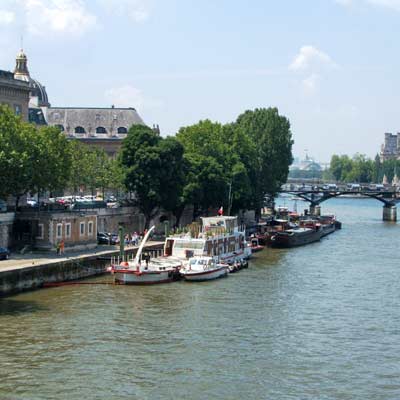
The Seine River meanders through the centre of Paris
The Parisian transport network is vast and efficient. Travelers shouldn't need more than the RER and Metro combination. They can be caught to virtually all the major sights and areas around the capital. You can purchase a contactless card ticket to travel on all the lines – tariffs are €1.90 per ride.
Even among the French themselves, the Parisian people are renowned for being curt and a little rude. Remember that this is a working, living metropolis, so expect central areas to be busy with commuters and the like. You'll also want to be especially cautious on public transport when carrying large luggage or travelling at night, because pickpocketing and thefts certainly aren't unheard of.
Brussels Airport (BRU) and the Charleroi Airport (CRL) combine to offer all sorts of long-haul and short-haul air links into the capital. The cheapest cross-continent flights on Ryanair and the like usually jet into CRL. Transatlantic and premium carriers usually go to BRU.
You can use Brussels City Shuttle to get to Charleroi for as little as €5 each way if booked online and in advance. Meanwhile, direct rail links go to Brussels Airport from Brussels Central, costing €8.60 and taking a little over 20 minutes in total.
Most of the sights and attractions on the itinerary above are within walking distance of each other. But be ready to make use of Brussels' efficient public transport system if the legs tire and the rain starts falling, though.
The metro and high-speed tram network links up most areas with its six lines. Tickets can be bought at the GO machines on virtually every station. They need to be validated at the orange boxes before use.

The bars and pubs in the historic centre of Brussels
In terms of travel safety, Brussels ranks well. Incidents involving tourists are rare, although thefts, bag snatches, and pickpocketing do occur in many of the visitor hotspots.
Try not to walk alone in the city centre after dark, particularly if you've been drinking. Never leave valuable items within sight if you're parking your car. Also always keep one eye on your handbag or wallet when riding the metro.
For hotels, the best area of Brussels is surely the district immediately around the Grand Place. The closest establishments to that UNESCO site typically cost oodles but ooze luxury. A few streets back and you can find affordable local B&Bs with plenty of charm.

oh we were stuck in the airport!

Copenhagen was a bit expensive...

All we did was drink beer in Brussels...

Muncih was crazy

And we got so burnt!

Remeber that night in Rome

oh we were stuck in the airport

So much fun kayaking

Berlin and that group from Austria!

There was such a view from that church

And we got so burnt!

Munich was eventful, wasn't it!

Such a view from that cathedral in Florence

Lisbon was such so much fun

Last summer was so much fun .... x

Remeber that night in Rome

Lisbon was such so much fun

Such a view from that cathedral in Florence

Munich was eventful, wasn't it!

And we got so burnt!

Remeber that night in Rome

All we did was drink beer in Brussels...

Berlin and that group from Austria!

Can't wait to go back to Dubrovnik

Remember that boat ride in Prague

Copenhagen was a bit expensive...
